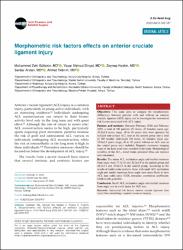| dc.contributor.author | Gültekin Muhammet Zeki | |
| dc.contributor.author | Dinçel, Yaşar Mahsut | |
| dc.contributor.author | Keskin, Zeynep | |
| dc.contributor.author | Arslan, Serdar | |
| dc.contributor.author | Yıldırım, Ahmet | |
| dc.date.accessioned | 2023-05-06T17:22:11Z | |
| dc.date.available | 2023-05-06T17:22:11Z | |
| dc.date.issued | 2023 | |
| dc.identifier.issn | 2687-4792 | |
| dc.identifier.uri | https://doi.org/10.52312/jdrs.2023.910 | |
| dc.identifier.uri | https://hdl.handle.net/20.500.11776/12101 | |
| dc.description.abstract | Objectives: This study aims to compare the morphometric differences between patients with and without an anterior cruciate ligament (ACL) injury and to investigate the anatomical risk factors associated with ACL injury. Patients and methods: Between February 2020 and February 2022, a total of 100 patients (57 males, 43 females; mean age: 36.2 +/- 6.8 years; range, 18 to 45 years) who were operated for isolated non-contact ACL tear as the patient group and a total of 100 healthy individuals (58 males, 42 females; mean age: 35.0 +/- 6.9 years; range, 18 to 45 years) without an ACL tear as the control group were included. Magnetic resonance imaging scans of the knee joint were included in the study. Morphological variables of the ACL, distal femur, proximal tibia, and menisci were measured. Results: The mean ACL inclination angle and medial meniscus bone angle were 37.7 +/- 3.8 and 20.2 +/- 2.9 in the patient group and 48.1 +/- 3.3 and 25.0 +/- 2.9 in the control group. According to the results of multivariate analysis, those with small ACL inclination angle and medial meniscus bone angle were more likely to have ACL tear (odds ratio: 0.128, intraclass correlation coefficient: 0.038-0.430, p= 0.001). Conclusion: Small ACL inclination angle and medial meniscus bone angle can be a risk factor for ACL tear. | en_US |
| dc.language.iso | eng | en_US |
| dc.publisher | Turkish Joint Diseases Foundation | en_US |
| dc.identifier.doi | 10.52312/jdrs.2023.910 | |
| dc.rights | info:eu-repo/semantics/openAccess | en_US |
| dc.subject | Anatomical risk factors | en_US |
| dc.subject | anterior cruciate ligament | en_US |
| dc.subject | knee injury | en_US |
| dc.subject | knee morphology | en_US |
| dc.subject | magnetic resonance imaging | en_US |
| dc.subject | Knee | en_US |
| dc.subject | Reconstruction | en_US |
| dc.subject | Laxity | en_US |
| dc.subject | Return | en_US |
| dc.title | Morphometric risk factors effects on anterior cruciate ligament injury | en_US |
| dc.type | article | en_US |
| dc.relation.ispartof | Joint Diseases And Related Surgery | en_US |
| dc.department | Fakülteler, Tıp Fakültesi, Cerrahi Tıp Bilimleri Bölümü, Ortopedi ve Travmatoloji Ana Bilim Dalı | en_US |
| dc.authorid | DİNÇEL, YAŞAR MAHSUT/0000-0001-6576-1802 | |
| dc.authorid | YILDIRIM, Ahmet/0000-0002-3953-091X | |
| dc.identifier.volume | 34 | en_US |
| dc.identifier.issue | 1 | en_US |
| dc.identifier.startpage | 130 | en_US |
| dc.identifier.endpage | 137 | en_US |
| dc.institutionauthor | Dinçel, Yaşar Mahsut | |
| dc.relation.publicationcategory | Makale - Uluslararası Hakemli Dergi - Kurum Öğretim Elemanı | en_US |
| dc.authorwosid | DİNÇEL, YAŞAR MAHSUT/AAF-9455-2019 | |
| dc.identifier.wos | WOS:000906594500001 | en_US |
| dc.identifier.pmid | 36700274 | en_US |



















